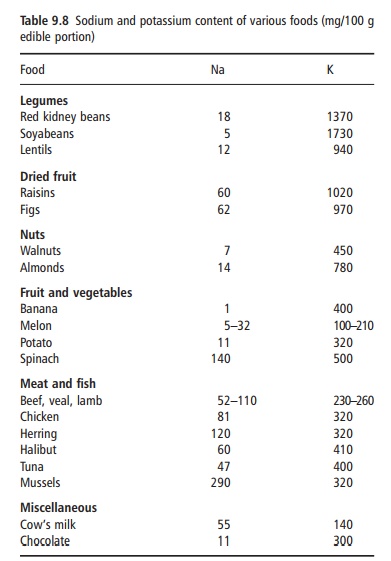Chapter: Introduction to Human Nutrition: Minerals and Trace Elements
Potassium: Toxicity, Genetic diseases, Requirements, dietary sources, Micronutrient interactions
Potassium
Potassium, sodium, and chloride make up the principal electrolytes within the body. In contrast to sodium and chloride, nutritional concerns with potassium are mainly concerned with the possibility of underconsumption.
Toxicity
Hyperkalemia, as a result of either a shift of potas-sium from cells to the ECF or excessive potassium retention, can be caused by major trauma and infec-tion, metabolic acidosis, Addison’s disease (aldoste-rone insufficiency) and chronic renal failure. Overuse of potassium supplements can also result in potas-sium excess. As with potassium depletion, the most important clinical consequence of potassium excess is cardiac arrest.
Assessing status
The plasma concentration of potassium is not a reliable index of whole-body potassium status. Total body potassium can be measured by 42K dilution or by whole body counting of the naturally abundant 40K to determine the amount of lean body tissue. More direct measures of tissue potassium can be obtained by muscle biopsies.
Requirement and dietary sources
Adult requirements for potassium are estimated to be about 2 g/day. Because of potential beneficial antago-nistic effects against high salt intakes, higher intakes (around 3.5 g/day) of potassium are considered to be optimal, although chronic intakes above 5.9 g/day may be dangerous for individuals with impaired renal function. Potassium, like sodium and chloride, is naturally widely distributed in foods (Table 9.8). Food processing (through leaching) may decrease potassium content as well as increasing salt content. Legumes, nuts, dried fruit, and fresh fruit, especially bananas, melons, avocados, and kiwi fruit, are rich sources of potassium. Major vegetable sources of potassium are potatoes and spinach, although cereal and dairy products, which have a lower potassium content but are consumed in large quantities, are also important dietary sources. In addition, meat and fish contain appreciable quantities of potassium. People who eat large quantities of fruit and vegetables

Micronutrient interactions
As might be expected from the close metabolic interactions among the major electrolytes, potassium and sodium dietary interactions may be important in determining the risk of coronary heart disease and stroke. Another potentially important concerns calcium. Potassium appears to have positive effects on calcium balance by regulating the acid–base balance and ameliorating any effects of sodium on calcium depletion.
Related Topics